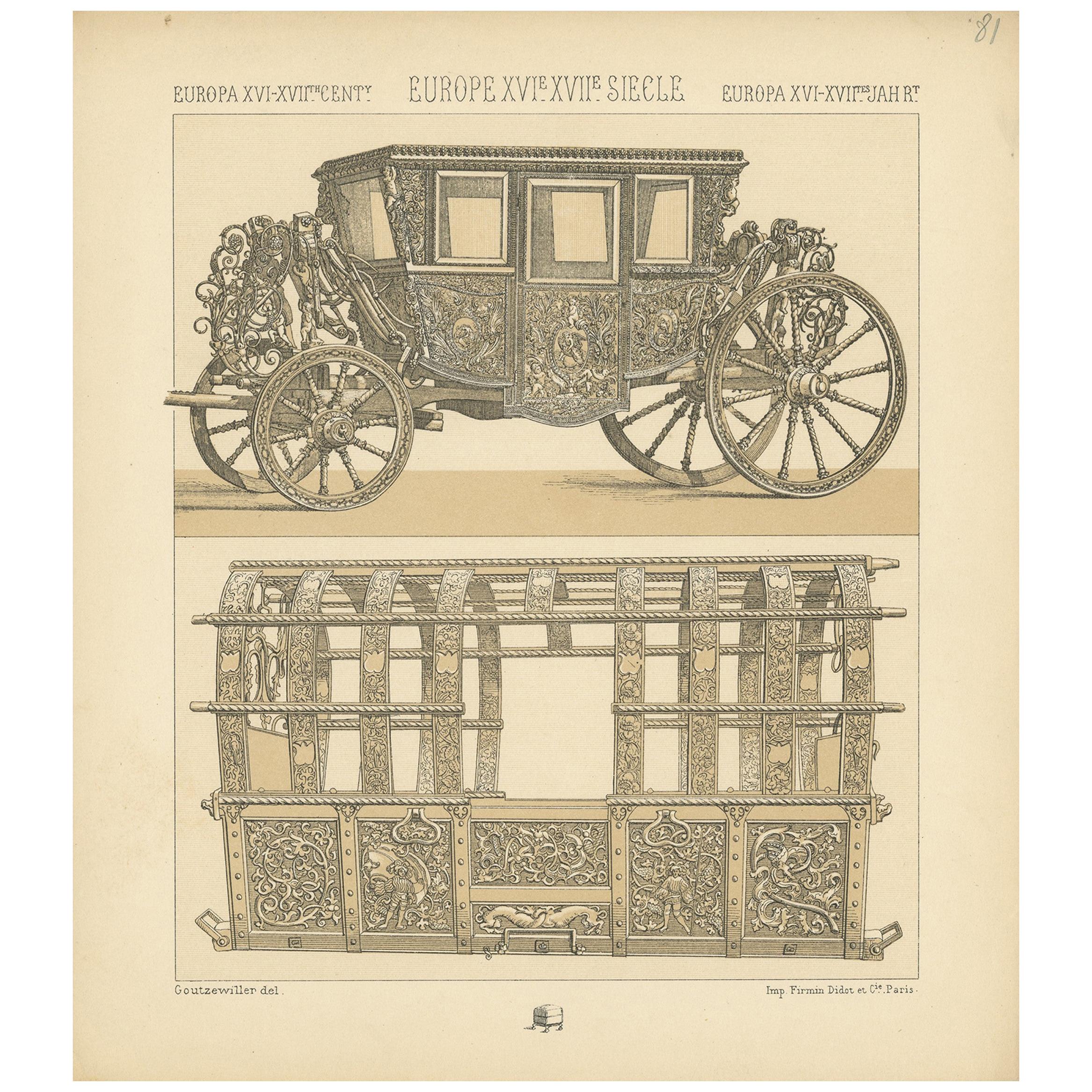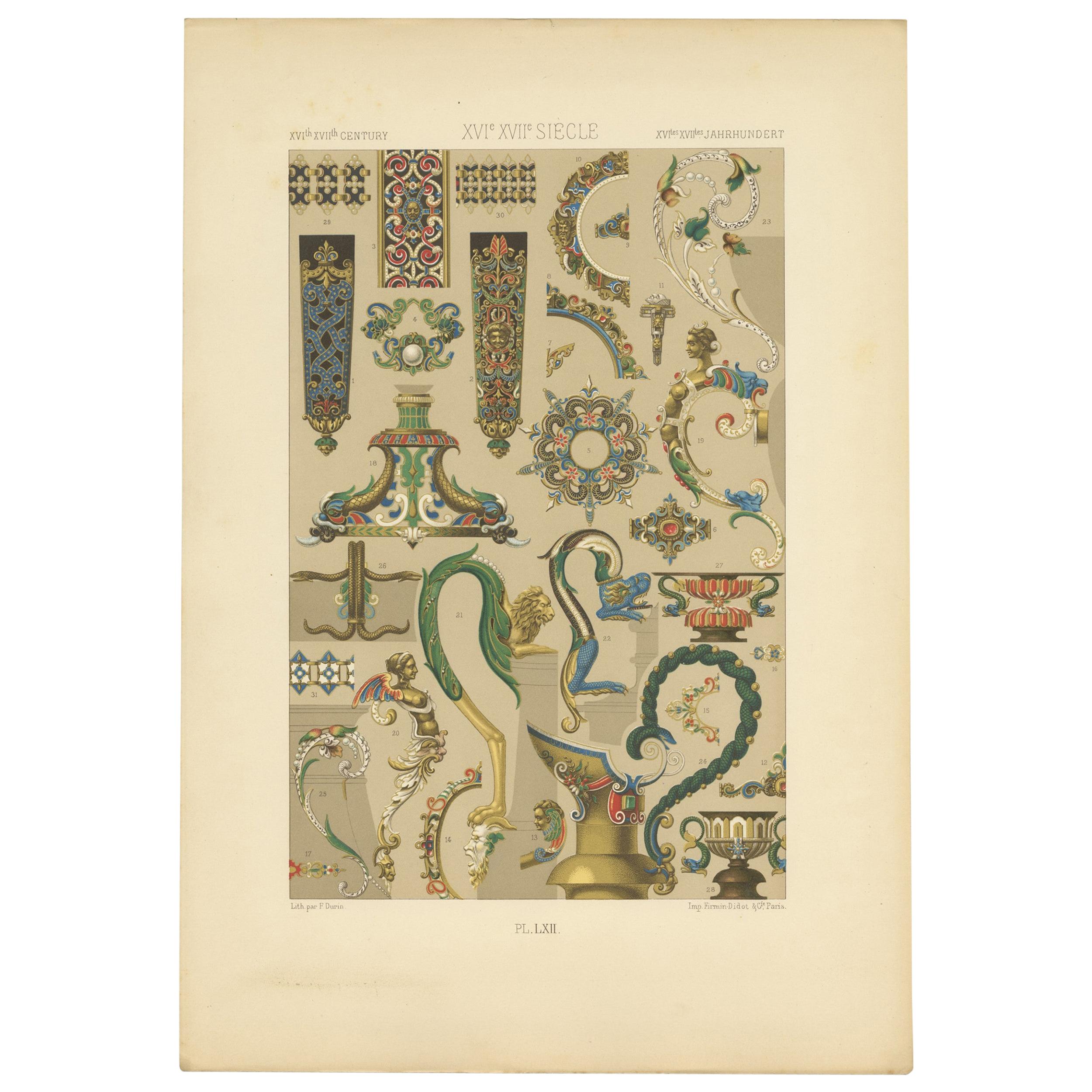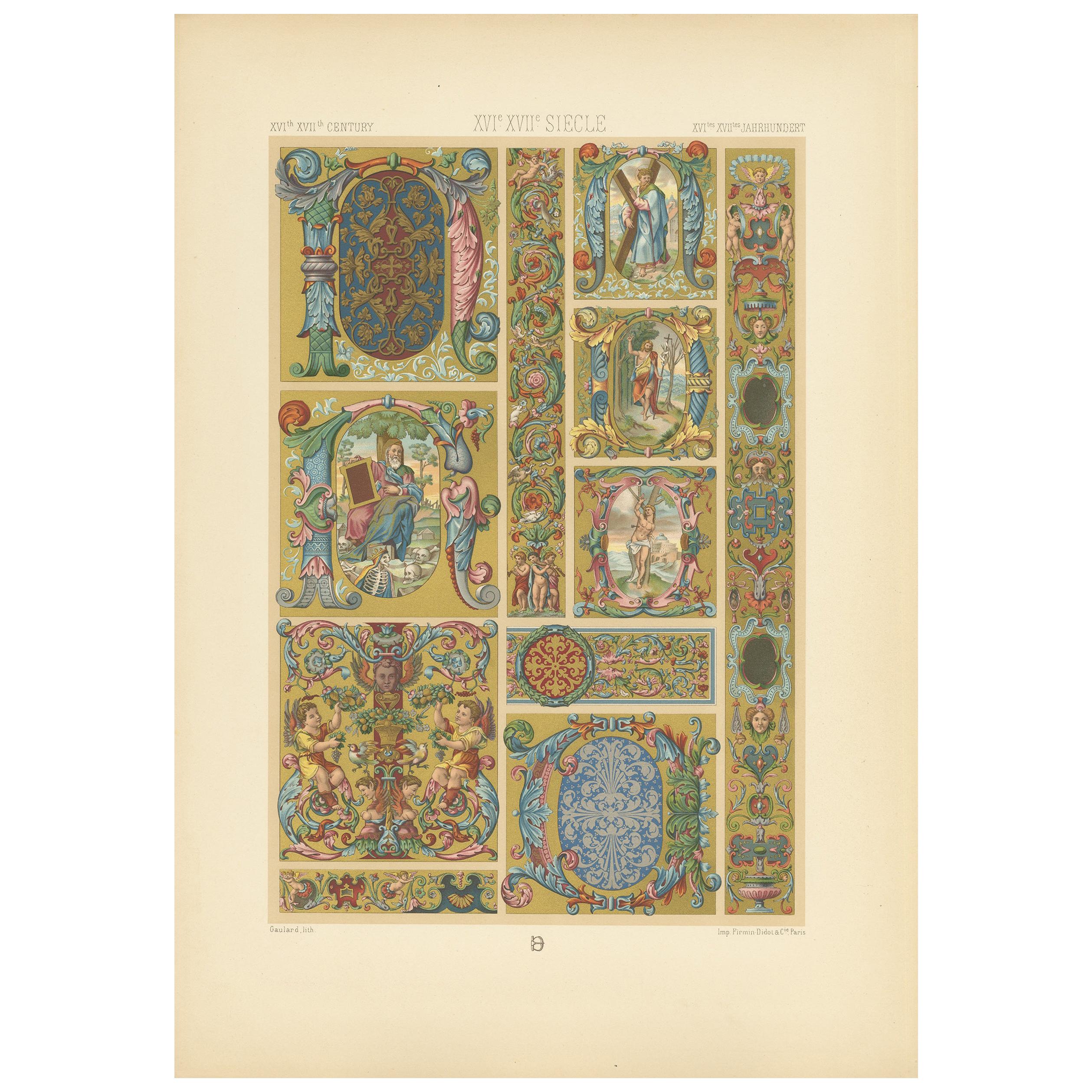Items Similar to Isabella Clara Eugenia, One of the Most Powerful Women in 16th and 17th-Century
Want more images or videos?
Request additional images or videos from the seller
1 of 6
Isabella Clara Eugenia, One of the Most Powerful Women in 16th and 17th-Century
About the Item
Antique portrait titled 'Isabella Clara Eugenia (..)'. Old portrait of Isabella Clara Eugenia. This print originates from 'Vaderlandsche historie, vervattende de geschiedenissen der nu Vereenigde Nederlanden, inzonderheid die van Holland (..)' by J. Wagenaar.
Artists and Engravers: Published by I. Tirion, Amsterdam.
Condition: Very good, please study image carefully.
Date: c.1750
Overall size: 14 x 23.5 cm.
Image size: 11 x 17 cm.
We sell original antique maps to collectors, historians, educators and interior decorators all over the world. Our collection includes a wide range of authentic antique maps from the 16th to the 20th centuries. Buying and collecting antique maps is a tradition that goes back hundreds of years. Antique maps have proved a richly rewarding investment over the past decade, thanks to a growing appreciation of their unique historical appeal. Today the decorative qualities of antique maps are widely recognized by interior designers who appreciate their beauty and design flexibility. Depending on the individual map, presentation, and context, a rare or antique map can be modern, traditional, abstract, figurative, serious or whimsical. We offer a wide range of authentic antique maps for any budget.
- Dimensions:Height: 9.26 in (23.5 cm)Width: 5.52 in (14 cm)Depth: 0 in (0.01 mm)
- Materials and Techniques:
- Period:
- Date of Manufacture:circa 1750
- Condition:Condition: Very good, please study image carefully.
- Seller Location:Langweer, NL
- Reference Number:
About the Seller
5.0
Platinum Seller
These expertly vetted sellers are 1stDibs' most experienced sellers and are rated highest by our customers.
Established in 2009
1stDibs seller since 2017
1,916 sales on 1stDibs
Typical response time: <1 hour
- ShippingRetrieving quote...Ships From: Langweer, Netherlands
- Return PolicyA return for this item may be initiated within 14 days of delivery.
More From This SellerView All
- Pl. 81 Antique Print of European 16th-17th Century Carriage, Racinet, circa 1880Located in Langweer, NLAntique print titled 'Europa XVI, XVIIth Cent - Europe XVIe, XVIIe Siecle - Europa XVIt, XVIItes Jahr'. Chromolithograph of European 16th-17th century carriage. This print originates...Category
Antique Late 19th Century Prints
MaterialsPaper
- Pl. 62 Antique Print of 16th-17th Century Ornaments by Racinet, 'circa 1890'Located in Langweer, NLAntique print titled 'XVIth XVIIth Century - XVIth XVIIth Siecle - XVIth XVIIth Jahrundert'. Chromolithograph of 16th-17th century ornaments and decorative arts. This print originate...Category
Antique Late 19th Century Prints
MaterialsPaper
- Antique Print of Decorative Art in the 16th and 17th Century, 1869Located in Langweer, NLOld print of decorative art in the 16th and 17th century. This print originates from 'L'Ornement polychrome'. A beautiful work containing about 2000 patterns of all the styles of Art...Category
Antique 19th Century Prints
MaterialsPaper
- Old City View of the City of Nice, France, in the 17th Century, 1855Located in Langweer, NLAntique print titled 'Nice au XVIIe Siecle d'apres une Gravure de l'Epoque'. Original antique print of the city of Nice, France. This print originates from the series 'Nice et ses en...Category
Antique 19th Century Prints
MaterialsPaper
- Pl. 98 Antique Print of 16th-17thCentury Italian Decorations by RacinetLocated in Langweer, NLAntique print titled '16th-17th Century - XVIc-XVIIc Siècle - XVIles-XVIIles Jahrhundert'. Chromolithograph of Italian manuscripts decorations, second half of the 16th century orname...Category
Antique Late 19th Century Prints
MaterialsPaper
- Original Hand-Colored Engraving of a 16th Century German Nobleman, 1805Located in Langweer, NLAntique costume print titled 'Deutscher Edelmann - Noble Allemand en 1577'. This print depicts a German nobleman. Originates from a rare costume book ...Category
Antique Early 1800s Prints
MaterialsPaper
You May Also Like
- 17th Century Etchingn "Adoration of the Magi" by Pietro Testa, circa 1640By Pietro TestaLocated in Cagliari, ITBeautiful etching representing the classic religious subject of the "Adoration of the Magi" by the Baroque painter and engraver Pietro Testa known as il Lucchesino. The print derives from an oil on canvas of the same name now in Montpelier. Identified by the TPL monogram on the right and the dedication signature. Paolo Bellini in the book "L'opera incisa di Pietro Testa" (The engraving work of Pietro Testa) ,published in 1976 by Neri Pozza in Vicenza, identifies this work as an example of the third state of three since, respect to the second state, the address of Gio Giacomo Rossi is added . In the lower margin there is the dedication in Latin to: Most illustrious and most reverend (cardinal) Gerolamo Bonvisi, Cleric of the Apostolic Chamber, D.D. The star on the left often blushes with the light of evil / Kings live here so that they recognize the Lord, / happy face good star shines benignly./ Petrus Testa Pietro Testa (1611–1650) was an Italian High Baroque artist active in Rome. He is best known as a printmaker and draftsman. He was born in Lucca, and thus is sometimes called il Lucchesino. He moved to Rome early in life. One source states he was ejected from the Cortona studio in 1631, soon after joining the workshop. Others state Testa trained under Pietro Paolini or under Domenichino, for whom he worked under the patronage of Cassiano dal Pozzo. He was friends with Nicolas Poussin and Francesco Mola. Some of his etchings, which often include work in drypoint, have a fantastic quality reminiscent of Jacques Callot, or embellishments of his Genoese contemporary Giovanni Benedetto Castiglione and even presciently suggest William Blake. His Sacrifice of Iphigenia appears to have influenced Tiepolo's rendition at Villa Valmarana Ai Nani in Vicenza. His early prints, from the 1630s, were often religious and were influenced by Federico Barocci...Category
Antique 17th Century Italian Baroque Prints
MaterialsPaper
- 17th-Century Botanical Engravings of Mosses and Ferns By John ParkinsonBy John ParkinsonLocated in Downingtown, PAJohn Parkinson was the last of the great English herbalists and one of the first of the great English botanists. Here the pair of prints show mosses and lichen and the other of ferns. From: Paradisi in sole Paradisus Terrestris: or a garden of all sorts of pleasant flowers...Category
Antique 1620s English Jacobean Prints
MaterialsPaper
- Important German Tabernacle Museum Piece 16th-17th CenturyLocated in Madrid, ESImportant German Tabernacle Museum Piece 16th-17th century IMPORTANT GERMAN TABERNACLE IN MUSEUM 16TH-17TH CENTURY EXCEPTIONAL SOUTHERN GERMAN TABERNACLE...Category
Antique 16th Century Religious Items
MaterialsFruitwood
- 17th Century Pen and Ink Architectural Drawing Signed Bartolomeo PedrelliLocated in New York, NY17th Century Italian Architectural Drawing of a Palazzo which has been done with pen and ink with a grey wash. Signed on reverse by Bart...Category
Antique 17th Century Italian Neoclassical Decorative Art
MaterialsPaper
- 17th Century Etchingn and Drypoint" Ceres and Phytalus" by Salvator Rosa, 1662By Salvator RosaLocated in Cagliari, IT" Ceres and Phytalus" To left, Phytalus, kneeling, receives the fig tree from the goddess Ceres, standing to right, as a reward for his hospitality. Etching and drypoint, circa 1662...Category
Antique 17th Century Italian Baroque Prints
MaterialsPaper
- 17th Century "Diana's Deer and Boar Hunt" Etching by Antonio TempestaBy Antonio TempestaLocated in Cagliari, ITA fine mythological etching by the great Italian engraver Antonio Tempesta (Florence, 1555 – Rome, 5 August 1630) printed by François L'Anglois or Langlois (12 May 1589 (baptised) – 13 January 1647),also called F. L. D. Ciartres (" Francois Langlois from Chartres"). Beautiful sheet , very sharp . The dimensions below are inclusive of the frame, the print without the frame measures 27x19 cm Antonio Tempesta, also called il Tempestino (1555 – 5 August 1630), was an Italian painter and engraver, whose art acted as a point of connection between Baroque Rome and the culture of Antwerp. Much of his work depicts major battles and historical figures. He was born and trained in Florence and painted in a variety of styles, influenced to some degree by "Counter-Maniera" or Counter-Mannerism. He enrolled in the Florentine Accademia delle Arti del Disegno in 1576. He was a pupil of Santi di Tito, then of the Flemish painter Joannes Stradanus. He was part of the large team of artists working under Giorgio Vasari on the interior decoration of the Palazzo Vecchio in Florence. His favourite subjects were battles, cavalcades, and processions. He relocated to Rome, where he associated with artists from the Habsburg Netherlands, which may have led to his facility with landscape painting. Among his followers was Marzio di Colantonio. Tempesta and the Flemish painter Matthijs Bril were commissioned by Pope Gregory XIII to paint wide panoramas of the Procession to Transfer the Relics of St. Gregory of Nazianzus (1572) for the loggias on the third floor of the Vatican Palace. He completed frescoes in the Palazzina Gambara at the Villa Lante in Bagnaia (1578-1609). From 1579–83, Tempesta participated in the decoration of the Villa Farnese in Caprarola, notably of this villa's Scala Regia. He is also known to have collaborated on frescoes in the Villa d'Este at Tivoli and the Palazzina Gamara at Villa Lante, Bagnaia. He painted a series of turbulent and crowded battle scenes for the Medici. He also completed a series of engravings on outdoor courtly hunting scenes. Tempesta painted frescoes for the Palazzos Colonna, the Doria Pamphilj, and for the Marchese Giustiniani in his Roman palace, where Tempesta collaborated with Paul Bril, and at Bassano di Sutri. He painted a Massacre of the Innocents for the church of Santo Stefano Rotondo in Rome. Tempesta is now best known as a printmaker in etching and engraving. He also left numerous etchings, among them: Plates from the Old Testament; twenty-four plates from the Life of St. Anthony; a set of 150 prints from Ovid’s Metamorphoses; 13 plates on The Labours of Hercules and four plates on respectively The ages of man; The entry of Alexander into Babylon; Diana and Actaon, and The crucifixion (1612). In 1612 he engraved a series of plates under the title "Batavorum cum Romanis Bellum" after designs of the Netherlandish artist Otto van Veen, also known as Vaenius (1556-1629) and court painter to Alessandro Farnese. Van Veen was influenced by the Italian mannerists but had developed his own style anticipating the Flemish baroque of his pupil Peter Paul Rubens. The series consists of 36 numbered engraved plates and illustrates the armed struggle between the ancient Dutch tribes and their Roman oppressors as narrated in Tacitus' Histories. Each plate bears at the bottom an engraved legend in Flemish and in Latin while a detailed explanation is printed on the otherwise blank verso. Plate I, signed 'Ant.Tempesta f. Anno 1611', shows 'Roma' and 'Batavia' in battle dress with respective scenic backgrounds, symbolizing the two nations. Fifteen other plates bear Tempesta's monogram. The plates depict heroic events, sieges, and battle scenes. This historicist work was very popular in its time. Tempesta also drew many designs for tapestries. François L’Anglois or Langlois (12 May 1589 (baptised) – 13 January 1647), also called F. L. D. Ciartres ("François Langlois from Chartres"), was a French print publisher, print seller, engraver, bookseller, art dealer, and painter. He is widely considered to have been the first important print publisher in France and to have contributed significantly to spreading awareness of contemporary artists' work throughout Europe. François L’Anglois was born in Chartres and baptised there on 12 May 1589. He visited Italy on several occasions: Rome in 1613 and 1614 and Genoa, Florence, and Rome again in 1621. On these trips he met Anthony van Dyck and Claude Vignon, who both painted his portrait. He also became acquainted with the engravers Stefano della Bella and François Collignon. It was probably around this time that he acquired the nickname of Chartres (Ciartres in Italian). In 1624–1625 he was associated with Vignon as an art dealer (paintings) and acted as a print collector for Thomas Howard, 14th Earl of Arundel, and Charles I of England...Category
Antique 17th Century French Baroque Prints
MaterialsPaper
Recently Viewed
View AllMore Ways To Browse
Tirion Map
Clara Antique
J Clara
16th 17th 18th C Portrait
18th C Portraits Women
Pair Chest Of Drawers Italian
Mid Century Wall Sculpture Black
Small Tall Cabinet
Aubusson French Wall Tapestry
Vertical Wall Sculpture
Single Display Cabinet
Faux Floral
Faux Florals
Vintage Glass Display Cabinet
E2 Vintage
Harvard Student
Slender Cabinet
Unusual Antique Rings





